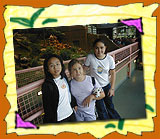Text types: Recounts
| Telling about past events |
Focus on grammar
When we tell about events which happened in the past we typically use doing verbs
![]() in the past
tense. Most doing verbs used in recounts are in
the past simple
in the past
tense. Most doing verbs used in recounts are in
the past simple ![]() .
.
Past simple
We use the past simple to talk about events which were completed in the past.
Yesterday I went with my friends Sophia and Lara to Ocean Park.
When we got off the cable car, we walked to the fast, fun rides.
We typically make verbs into the past simple by adding -ed to
the verb base eg walked. However, there are many commonly used past simple verbs, however, which have irregular
forms. ![]()
To make a past simple verb negative, we add did not to the base form
of the verb eg did not
wear. In more informal texts we often contract the negative past simple by
joining did and not together into one shortened form eg didn't
wear. ![]()
Doing verbs in the past simple are used in the ORIENTATION, RECORD OF EVENTS and RE-ORIENTATION stages of a recount.
| Here are some events from the ORIENTATION of the recount My day out at Ocean Park. The writer uses doing clauses with doing verbs in the past simple to write about these events: |
|
|
|
|
||||||||||||||||||||||||||||||
Here are some events from the RECORD OF EVENTS
of My day out at Ocean Park:
|
|
|
||||||||||||||||||||||||
Here are some events from the RE-ORIENTATION of My day out at Ocean Park:
 |
|
||||||||||||||||||||
In the CODA
at the end of the story, the writer uses past tense relating clauses and a
past tense thinking clause to evaluate the whole day.
 |
|
|||||||||||||||
At the very end of the CODA,
to finish off the recount, the writer stops writing about the past
and tells the reader about a present hope that similar events will happen in the
future.
| thinking
clause |
doing clause | ||||
| thinking
verb present tense |
event |
||||
| I |
hope |
(that) | something similar | will happen | again soon! |
| To see how doing verbs in the past simple are used to tell about past events in the recount My day out at Ocean Park click here: | 
|
For more information see:
|
||
To give us feedback about this section, click here or on the Comment button at the top of the screen.
If you have any questions about this section, visit the Language Corner.
If you have any questions or suggestions about how to teach this section, send a message to the Teaching Corner.